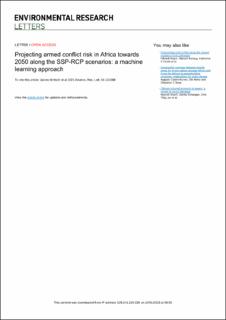| dc.contributor.author | Hoch, Jannis M. | |
| dc.contributor.author | de Bruin, Sophie P | |
| dc.contributor.author | Buhaug, Halvard | |
| dc.contributor.author | von Uexkull, Nina | |
| dc.contributor.author | van Beek, Rens | |
| dc.contributor.author | Wanders, Niko | |
| dc.date.accessioned | 2023-02-22T12:02:17Z | |
| dc.date.available | 2023-02-22T12:02:17Z | |
| dc.date.created | 2022-01-31T11:48:35Z | |
| dc.date.issued | 2021 | |
| dc.identifier.citation | Environmental Research Letters. 2021, 16 (12), 1-22. | en_US |
| dc.identifier.issn | 1748-9326 | |
| dc.identifier.uri | https://hdl.handle.net/11250/3053239 | |
| dc.description.abstract | In the past decade, several efforts have been made to project armed conflict risk into the future. This study broadens current approaches by presenting a first-of-its-kind application of machine learning (ML) methods to project sub-national armed conflict risk over the African continent along three Shared Socioeconomic Pathway (SSP) scenarios and three Representative Concentration Pathways towards 2050. Results of the open-source ML framework CoPro are consistent with the underlying socioeconomic storylines of the SSPs, and the resulting out-of-sample armed conflict projections obtained with Random Forest classifiers agree with the patterns observed in comparable studies. In SSP1-RCP2.6, conflict risk is low in most regions although the Horn of Africa and parts of East Africa continue to be conflict-prone. Conflict risk increases in the more adverse SSP3-RCP6.0 scenario, especially in Central Africa and large parts of Western Africa. We specifically assessed the role of hydro-climatic indicators as drivers of armed conflict. Overall, their importance is limited compared to main conflict predictors but results suggest that changing climatic conditions may both increase and decrease conflict risk, depending on the location: in Northern Africa and large parts of Eastern Africa climate change increases projected conflict risk whereas for areas in the West and northern part of the Sahel shifting climatic conditions may reduce conflict risk. With our study being at the forefront of ML applications for conflict risk projections, we identify various challenges for this arising scientific field. A major concern is the limited selection of relevant quantified indicators for the SSPs at present. Nevertheless, ML models such as the one presented here are a viable and scalable way forward in the field of armed conflict risk projections, and can help to inform the policy-making process with respect to climate security. | en_US |
| dc.language.iso | eng | en_US |
| dc.publisher | IOP Publishing | en_US |
| dc.rights | Navngivelse 4.0 Internasjonal | * |
| dc.rights.uri | http://creativecommons.org/licenses/by/4.0/deed.no | * |
| dc.title | Projecting armed conflict risk in Africa towards 2050 along the SSP-RCP scenarios: a machine learning approach | en_US |
| dc.title.alternative | Projecting armed conflict risk in Africa towards 2050 along the SSP-RCP scenarios: a machine learning approach | en_US |
| dc.type | Peer reviewed | en_US |
| dc.type | Journal article | en_US |
| dc.description.version | publishedVersion | en_US |
| dc.source.pagenumber | 1-22 | en_US |
| dc.source.volume | 16 | en_US |
| dc.source.journal | Environmental Research Letters | en_US |
| dc.source.issue | 12 | en_US |
| dc.identifier.doi | 10.1088/1748-9326/ac3db2 | |
| dc.identifier.cristin | 1994484 | |
| dc.relation.project | EC/H2020/648291 | en_US |
| cristin.ispublished | true | |
| cristin.fulltext | original | |
| cristin.qualitycode | 2 | |

